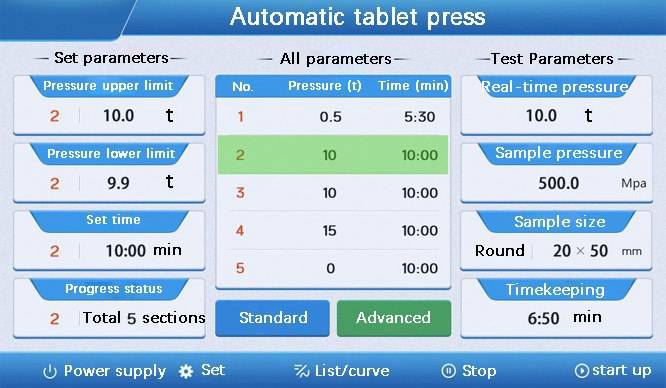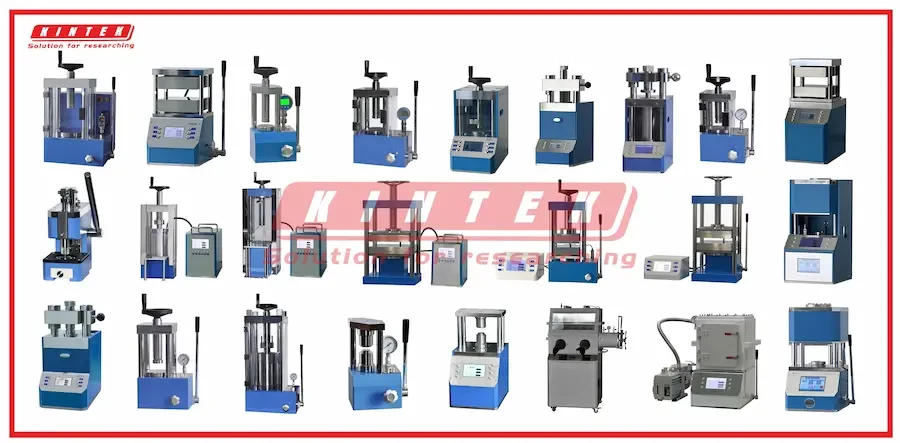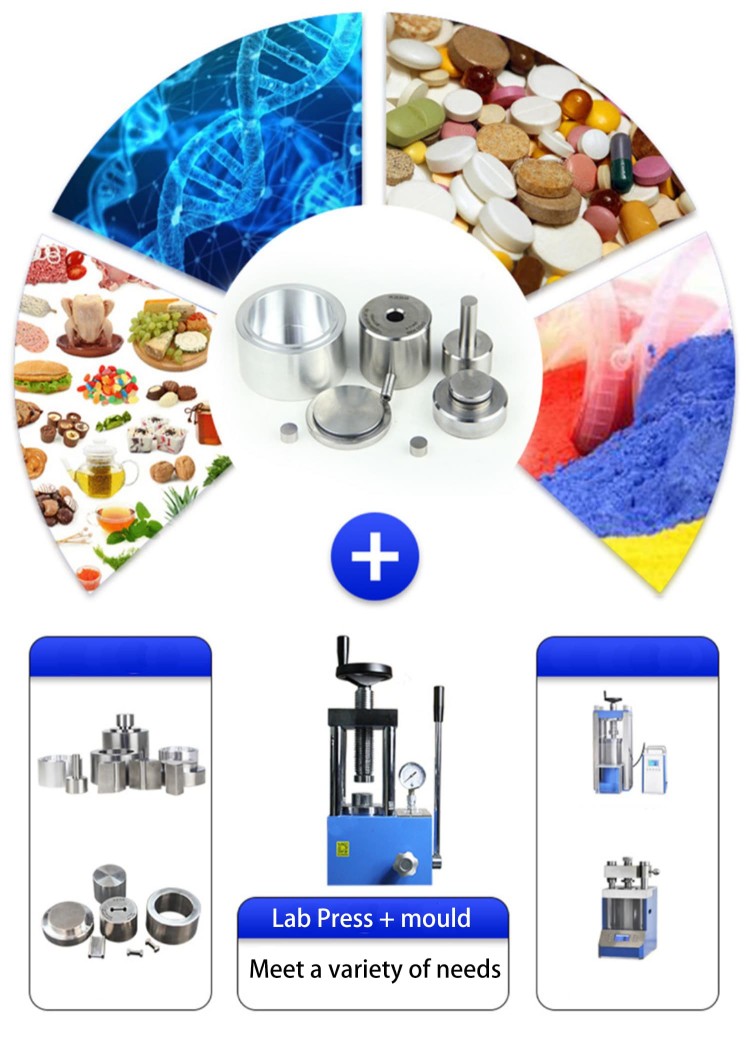
Manual Heated Lab Press
24T 30T 60T Heated Hydraulic Press Machine with Heated Plates for Laboratory Hot Press
Item Number : PCH
Price varies based on specs and customizations
- Working pressure
- 0-40 T
- Heating control
- Digital programmed control
- Heating temperature
- 300 / 500℃
- Cooling method
- Chiller circulator
Shipping:
Contact us to get shipping details Enjoy On-time Dispatch Guarantee.
Why Choose Us
Reliable PartnerEasy ordering process, quality products, and dedicated support for your business success.
Applications
Hydraulic Lab Press is widely used in material researching labs,pharmacy,catalytic reaction,ceramics, electronic industries, it is one high efficient equipment for the sample preparing, due to its small footprint, it easy to carry and move, can work inside the vacuum glove box for processing under vacuum environment. Hydraulic Heat Lab Press can also process hot press function with heating plates, which can serve the particular material processing.
The Hydraulic Heat Lab Press can heat the sample during the pressing process to meet some laboratory sample preparation requirements.
Feature
- Fast heating, heating plate can be single side or double side
- Water circulating fast cooling to protect the press
- Max. Heating temperature is up to 350 ℃
- Small footprint, light weight, easy to carry and move, nice fitting vacuum glove box
Detail & Parts
![Double plate manual heat press machine [100×100]](https://image.kindle-tech.com/images/products/15/b192e3337fad529ad3b29f023c23aaac67b6ea20b4720.jpg)
![Double plate manual heat press machine [180×180]](https://image.kindle-tech.com/images/products/15/b43f7768e22f05b50277b363e62c36ad67b6ea452e013.jpg)
![Double plate manual heat press machine [200×200]](https://image.kindle-tech.com/images/products/15/1be16cccf75a9aa2da13737b3a404cfa67b6ea8dbf5cc.jpg)
Operation interface

- Standard interface: You can set the upper and lower plate heating temperature and constant temperature time separately in this interface.
- Zero button: Calibrate the pressure and return the pressure to zero.
- Upper plate button: Heat the upper heating plate.
- Lower plate button: Heat the lower heating plate.
- Timer switch: You can turn the timer function on and off.

- Start button: You can heat up according to the multi-stage heating program.
- Stop button: During the heating process, you can stop the heating process.
- Setting button: Click the setting button to enter the setting menu.

- List/Graph: You can switch between list and graph display.
Advantages
- The upper plate adopts electroplated countersunk head hexagonal screws, beautiful and space-saving
- Chrome-plated cylinder, smooth surface, no rust, good sealing rubber ring, no oil leakage
- One-piece main board structure, oil pool, main board, oil cylinder in a body, no seal connection
- Extended pulling spring, good rebound effect, not easy to deformation, can achieve the cylinder 30mm return without deformation
- All aluminum alloy hand wheel, beautiful, practical, not easy to break
- Small size, light weight, no oil leakage, can be used in the glove box
- Mold using Japanese high-speed steel, good material, high hardness, no deformation, long service life
- Digital display pressure gauge, more accurate pressure control, pressure display accuracy of 0.01MPa
- Oil pool outside the host, easy to replace the oil, and the oil circuit increased the hydraulic oil filtration device
- Special plunger, using special custom sealing structure, excellent sealing effect
- Pressurizing device, placed in the lowermost corner of the mainframe, the angle is reasonable, pressurizing force does not tilt back
Technical specifications
| Instrument model | PCH-24T1010 | PCH-30T2020 | PCH-30T1818 |
|---|---|---|---|
| Pressure Range | 0-24.0 tons | 0-30.0 tons | 0-30.0 tons |
| piston diameter | 95mm (d) in chrome plated oil cylinder | 110mm (d) in chrome plated oil cylinder | 150mm (d) in chrome plated oil cylinder |
| Main overall structure | Equipment without sealed connections to reduce oil leakage points | Equipment without sealed connections to reduce oil leakage points | Equipment without sealed connections to reduce oil leakage points |
| Mold heating temperature | Room temperature-300.0C/500.0C | Room temperature -300.0C/500.0C | Room temperature-300.0C/500.0C |
| Insulation method | Imported insulation board | Imported insulation board | Imported insulation board |
| Cooling method | Quick cooling with water cooling [optional water cooling machine] | Quick cooling with water cooling [optional water cooling machine] | Quick cooling with water cooling [optional water cooling machine] |
| Hot platen size | 100×100mm (M×N)with chamfer | 200×200mm(M×N) | 180×180mm (M×N) |
| Host size | 245×175×500mm(K×P×H) | 405×260×525mm(K×P×H) | 405 ×260×525mm(K×P×H) |
| Dimensions | 500×175×500mm(L×W×H) | 950×260×525mm(L×W×H) | 950×260×525mm(L×W×H) |
| power supply | 600 W(220V/110V can be customized) | 1200 W(220V/110V can be customized) | 1000 W(220V/110V can be customized) |
| Weight | 60 Kg | 180 Kg | 180 Kg |

- Convenience: The electric heating tablet press has the advantages of small size, fast heating, rapid cooling, and easy use. It is widely used in the plastic and rubber industry.
- Efficiency: The use of water cooling cycle cooling can accelerate the cooling rate of the sample after molding, reduce the sample preparation time, and improve efficiency.
- Accuracy: PLC program temperature control is adopted to effectively prevent the temperature from overshooting when the heating mold heats up. The temperature display of 0.1°C is more accurate.
Operation steps
How to replace accessories and precautions

Step 1. Place the mold in the tablet press.

Step 2. Enter the required heating temperature and time.

Step 3. Click the heating button to start heating.

Step 4: Press the heating button on the upper and lower boards to start heating them up.

Step 5. Pressurize the sample.

Step 6. Take out the cooled sample.
Full range of lab press types

Click to view our full range of lab press products.
Any question? Our experts have helped many laboratories choose their lab press, contact us now!
Full range of types of laboratory press molds
We have a full range of molds for you to choose from, and the molds fit the body perfectly.
If you need molds with special shapes, we can also customize them for you.

Warnings
Operator safety is the top important issue! Please operate the equipment with cautions. Working with inflammable& explosive or toxic gases is very dangerous, operators must take all necessary precautions before starting the equipment. Working with positive pressure inside the reactors or chambers is dangerous, operator must fellow the safety procedures strictly. Extra caution must also be taken when operating with air-reactive materials, especially under vacuum. A leak can draw air into the apparatus and cause a violent reaction to occur.
Designed for You
KinTek provide deep custom made service and equipment to worldwide customers, our specialized teamwork and rich experienced engineers are capable to undertake the custom tailoring hardware and software equipment requirements, and help our customer to build up the exclusive and personalized equipment and solution!
Would you please drop your ideas to us, our engineers are ready for you now!
FAQ
What Are The Advantages Of Using A Hydraulically Heated Laboratory Press?
What Does A Hydraulic Lab Heat Press Do?
What Types Of Samples Or Materials Can Be Processed In A Hydraulically Heated Laboratory Press?
How Does A Hydraulically Heated Laboratory Press Work?
How Can The Performance Of A Hydraulically Heated Laboratory Press Be Optimized?
4.8
out of
5
Fantastic lab press! The heating plates are a game-changer, allowing for precise temperature control and rapid cooling. The digital display makes it easy to monitor pressure and temperature, and the safety features give me peace of mind.
4.9
out of
5
This press is a lifesaver in our lab. It's incredibly easy to use and maintain, and the results are always consistent. The build quality is top-notch, and I'm confident it will last for years to come.
4.7
out of
5
I highly recommend this press to any lab that needs a reliable and efficient way to prepare samples. It's fast, accurate, and easy to use. The customer service from KINTEK SOLUTION is also excellent.
4.6
out of
5
I've been using this press for a few months now and I'm very impressed. It's made sample preparation so much easier and faster. The pressure control is precise and the temperature range is wide enough for all my needs.
4.8
out of
5
This is the best lab press I've ever used. It's incredibly well-made and the features are top-notch. The heating plates are a huge plus, and the digital display makes it easy to monitor the pressure and temperature.
4.9
out of
5
I'm so glad I bought this press. It's made my work so much easier. The sample preparation is now faster and more efficient, and the results are more accurate. I highly recommend this press to any lab.
4.7
out of
5
This press is a great value for the price. It's easy to use and maintain, and the results are consistent. I've been using it for a few months now and I've had no problems. I would definitely recommend it to other labs.
4.6
out of
5
I'm very happy with this press. It's made sample preparation much faster and easier. The temperature control is precise and the pressure gauge is easy to read. I would definitely recommend this press to other labs.
REQUEST A QUOTE
Our professional team will reply to you within one business day. Please feel free to contact us!
Related Products

Automatic High Temperature Heated Hydraulic Press Machine with Heated Plates for Lab
The High Temperature Hot Press is a machine specifically designed for pressing, sintering and processing materials in a high temperature environment. It is capable of operating in the range of hundreds of degrees Celsius to thousands of degrees Celsius for a variety of high temperature process requirements.

Manual High Temperature Heated Hydraulic Press Machine with Heated Plates for Lab
The High Temperature Hot Press is a machine specifically designed for pressing, sintering and processing materials in a high temperature environment. It is capable of operating in the range of hundreds of degrees Celsius to thousands of degrees Celsius for a variety of high temperature process requirements.

Heated Hydraulic Press Machine with Integrated Manual Heated Plates for Lab Use
Efficiently process heat-pressing samples with our Integrated Manual Heated Lab Press. With a heating range up to 500°C, it's perfect for various industries.

Manual Heated Hydraulic Press Machine with Heated Plates for Laboratory Hot Press
The Manual Heat Press is a versatile piece of equipment suitable for a variety of applications, operated by a manual hydraulic system that applies controlled pressure and heat to the material placed on the piston.

Heated Hydraulic Press Machine with Heated Plates Split Manual Laboratory Hot Press
Efficiently prepare your samples with our Split Manual Heated Lab Press. With a pressure range up to 40T and heating plates up to 300°C, it's perfect for various industries.

Automatic Heated Hydraulic Press Machine with Heated Plates for Laboratory Hot Press 25T 30T 50T
Efficiently prepare your samples with our Automatic Heated Lab Press. With a pressure range up to 50T and precise control, it's perfect for various industries.

Vacuum Hot Press Furnace Machine Heated Vacuum Press
Discover the advantages of Vacuum Hot Press Furnace! Manufacture dense refractory metals & compounds, ceramics, and composites under high temp and pressure.

Explore versatile Hydraulic Hot Press molds for precise compression molding. Ideal for creating various shapes and sizes with uniform stability.

Customer Made Versatile CVD Tube Furnace Chemical Vapor Deposition Chamber System Equipment
Get your exclusive CVD furnace with KT-CTF16 Customer Made Versatile Furnace. Customizable sliding, rotating, and tilting functions for precise reactions. Order now!

KT-PE12 Slide PECVD System: Wide power range, programmable temp control, fast heating/cooling with sliding system, MFC mass flow control & vacuum pump.

Square Lab Press Mold for Laboratory Applications
Create uniform samples easily with Square Lab Press Mold - available in various sizes. Ideal for battery, cement, ceramics, and more. Custom sizes available.

Easily release samples from our lab infrared press mold for accurate testing. Ideal for battery, cement, ceramics, and other sample preparation research. Customizable sizes available.

Discover precision polygon press molds for sintering. Ideal for pentagon-shaped parts, our molds ensure uniform pressure and stability. Perfect for repeatable, high-quality production.

Square Bidirectional Pressure Mold for Lab Use
Discover precision in molding with our Square Bidirectional Pressure Mold. Ideal for creating diverse shapes and sizes, from squares to hexagons, under high pressure and uniform heating. Perfect for advanced material processing.
Related Articles

Choosing the Right Warm Isostatic Press: Key Factors to Consider
Guidelines for selecting a suitable warm isostatic press based on cavity size, pressure range, accuracy, temperature, capacity, ease of use, maintenance, and environmental restrictions.

Hydraulic Heated Lab Pellet Press: Comprehensive Guide to Selection and Usage
Explore the features and applications of hydraulic heated lab pellet presses. Learn how to choose the right model for your research needs and maximize efficiency in material science labs.

More Than a Squeeze: The Physics and Psychology of the Hydraulic Hot Press
An insight into the hydraulic hot press, where Pascal's Law meets thermodynamics to reshape materials. A story of force, heat, and control.

The Physics of Flawless Materials: Deconstructing the Hydraulic Hot Press
Discover how the synergy of Pascal's Law and thermal energy in a hydraulic hot press enables precise, repeatable material bonding and forming.

Hydraulic Tablet Press: Comprehensive Guide to Design, Operation, and Applications
Explore the advanced features, operational principles, and diverse applications of hydraulic tablet presses in various industries. Learn how these machines ensure high-quality tablet production with detailed insights.

Why Your Composite and Polymer Parts Keep Failing: The Secret Is Simultaneous Heat and Pressure
Struggling with inconsistent composite or polymer bonding? Discover why separate heating and pressing fails and how a hot hydraulic press ensures repeatable, high-quality results.

How to choose a laboratory hot press
The laboratory hot pressing machine is suitable for laboratory users who are strict about sample pressing temperature, pressure control accuracy and need a wide size mold for pressing samples. The new lab hot press of KINDLE TECH has a double-plate structure and a pressing force of 0~40 tons.

How Much Pressure Do You Need in a Heated Lab Press
Lab presses are versatile and essential tools that are used in various laboratory applications.

Automatic flat plate heat press operating steps

Force and Fire: A Guide to Material Transformation with Hot and Cold Pressing
Hot and cold pressing aren't just about temperature; they are different philosophies of material creation. Learn when to use force vs. force and fire.

Pressure and Heat: Forging Certainty into Matter
A hot press doesn't just shape materials; it eliminates hidden flaws and forges atomic-level trust. Learn the physics of material integrity.

Applications and Importance of Hydraulic Press in Laboratories
A hydraulic press is a machine that uses the pressure generated in a confined fluid to configure metals, plastics, rubber, and other materials. Its operation is governed by Pascal’s principle, which states that pressure applied to a confined fluid is transmitted unaltered throughout the fluid.
